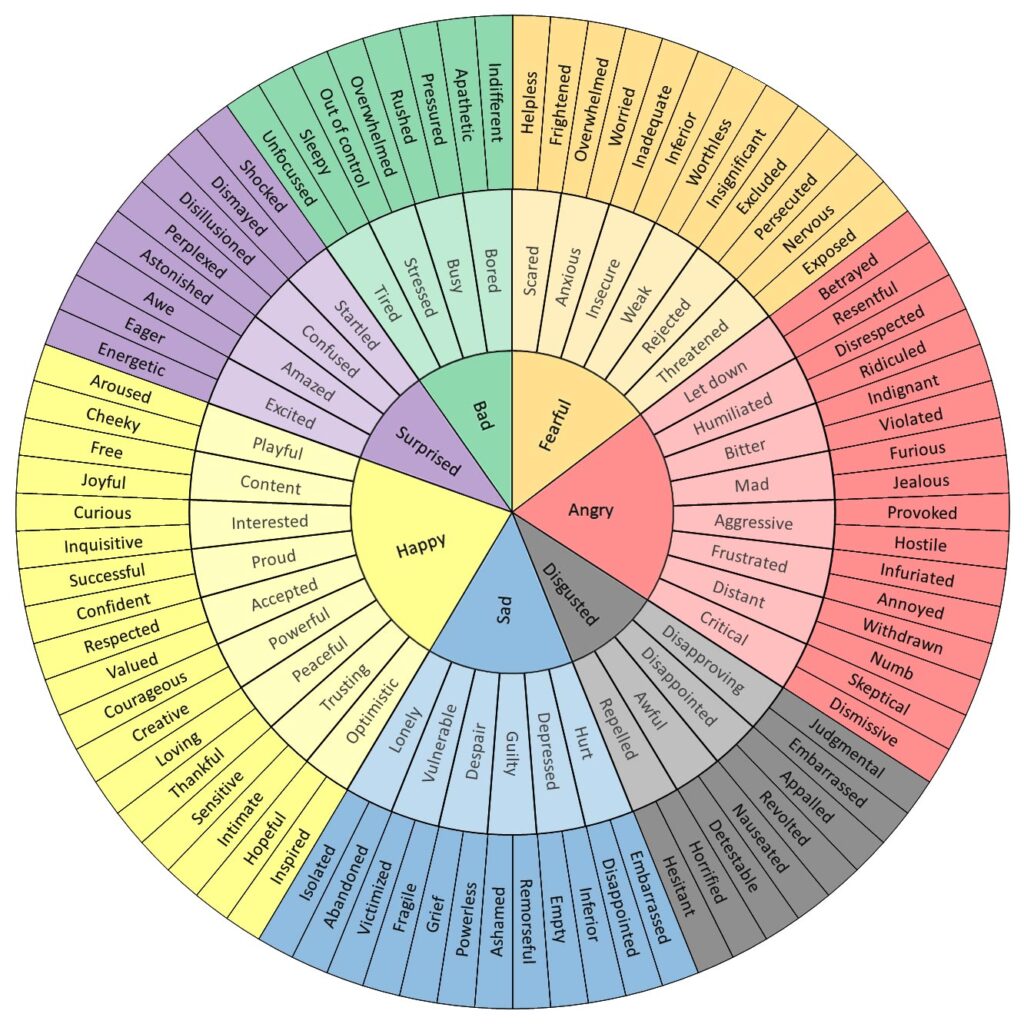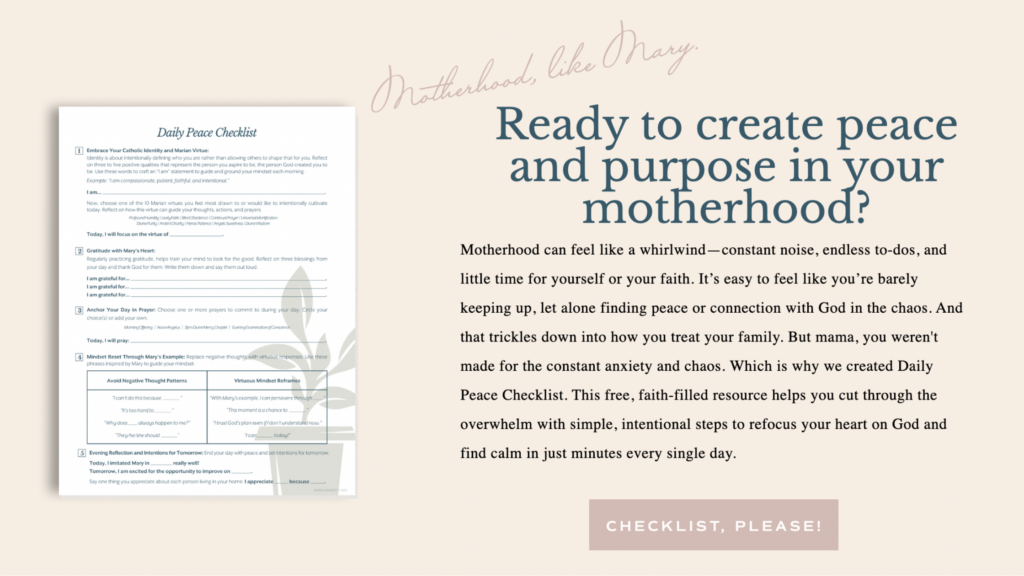Almost every mother and spiritual mother we talk to has a part of their day that makes them feel like they’re this close (*pinches fingers*) to snapping.
Maybe it’s your boss who always stops by your desk at 4:59 pm with “one more quick thing.” Or when you’re trying to leave your house and suddenly no one in your family has ever heard of shoes. Maybe it’s the person you have to deal with (at work, in your parish, in your extended family) who just drains the life out of you. Or the constant interruptions when you finally sit down to pray, and your phone buzzes, someone yells “Mom!”, or the baby wakes up.
That’s what we want to dig into today. Because we firmly believe a Marian Mindset means taking every thought captive to the will of God and letting nothing disturb our peace. So, today we’re going to take that moment and make it lighter. Starting with us. What we’ll walk through today doesn’t require anyone else to change or be different (as much as we’d like that). Because we are only in charge of our own thoughts and feelings, we can have a totally different experience of our lives when we take charge of those.
Grab a scrap of paper or your notes app. Let’s do this together.
Step One: Name Your Pressure Point
Take a moment to think through your day. What do you dread the most? What feels like it takes the most out of you—mentally, emotionally, spiritually? We call this your pressure point, the place where the weight of the day feels heaviest. Go ahead and write it down. Just as an example, we’ll do one together (but you can apply everything we’ll talk about to your specific situation!).
We’re gonna pick: bedtime chaos.
Step Two: Notice How You Feel
Once you’ve named your pressure point, take a couple of minutes and jot down what feelings you have around this part of the day. NOTE: Don’t judge anything that comes up. I know that’s hard, but we’re going to imagine a good friend is sitting across from you, telling you how stressed and frustrated she feels about this moment of her day. You wouldn’t lecture her, or tell her to “just be more patient.” You’d nod, listen, maybe say, “That sounds really hard.”
Do the same for yourself. Write down everything honestly—even the thoughts you wish you didn’t have—as though you’re holding space for a friend.
Here are some feelings so many of us have about bedtime chaos”
- “By the end of the day, I am so done with everyone and short on patience.”
- “I dread bedtime before it even starts.”
- “The kids go wild the moment I say it’s time—it feels like I lose control.”
- “I yell, then feel guilty after.”
- “I wish I could just enjoy bedtime, but right now it feels like a battle.”
- “Bedtime is always on me because my husband just yells at everyone, and I’d rather be stressed to the max and sort of calm than have him screaming at everyone.”
- “Bedtime ruins everything. The kids stop listening and acting like this is the first time we’ve ever had to get ready for bed. I’m exhausted.”
Write down anything that comes to mind. This step is not about fixing anything yet, it’s about naming what feels true right now. Naming feelings without judgment gives us a place to start.
Step 3: Let’s Go Deeper
Once you’ve written down how you feel, pause and remind yourself: Your feelings are not sins. The Catechism reminds us that our emotions are morally neutral (CCC 1767 and 1771), and emotions mostly give us information about what matters to us. And ALL emotions come from your thoughts. (Which is amazing news for us because thoughts can be explored and examined and changed.)
Step 3A: Name the Circumstance
Now, we’re going to spend a minute writing down just the facts of the situation. Facts are things you could prove in court. They’re just what an outside observer with a clipboard would see, no interpretation added.
For example:
- “Bedtime starts at 8:00.”
- “Kids get out of bed 3–4 times before finally falling asleep.”
- “I raised my voice twice.”
That’s it. No adjectives, no story about what it means. This step is so important because it keeps you grounded in reality. When we’re tired or frustrated, we often mix the circumstance with our interpretation:
- “I’m a bad mom.”
“My kids are so wild.” - “Nobody respects me.”
But those are thoughts, not facts. They add extra (unwanted/unneeded!) emotional weight before we’ve even had a chance to breathe!
Quick Check:
If you’re not sure you’ve got a neutral circumstance, ask:
- Could everyone in the room agree this happened?
- Would it hold up if I had to testify about it in court?
- Could a video camera capture this?
Step 3B: Name the Thought
Across from each of your circumstance/facts write down the first thought your brain offers you about that circumstance. Draw an arrow from the circumstance to the thought. (This will help you see that the thought isn’t the same as what happened, it’s your interpretation.)
| Circumstance (Fact) | Thought (Your Interpretation) |
| Bedtime starts at 8:00, kids get out of bed 3–4 times before falling asleep. | “They never listen.” |
| I raised my voice twice. | “I’m a bad mom.” |
| Baby woke up twice during bedtime routine. | “I’ll never get a break.” |
When we write down the facts and our feelings side-by-side (or with arrows), we can literally see the space between what happened and what you think about it. That space is powerful because it means you’re not stuck.
Step 3C: Name the Feeling
Once you’ve written your thought, ask yourself: “When I think this thought, how do I feel?”
Be as specific as you can. Go beyond “bad” or “stressed.” Try to find the exact word:
- Overwhelmed
- Angry
- Resentful
- Defeated
- Exhausted
- Powerless
- Frustrated
- Sad
- Guilty
Sometimes it’s hard to find the right word, especially when your brain just wants to scream “EVERYTHING IS TOO MUCH.” If that feels a little too accurate, you can use an emotions wheel to help. Looking at the wheel below, pick the emotion that most accurately describes what you’re feeling. Maybe you’re not just mad… maybe it’s irritated or disrespected. Or maybe it’s not just “tired”… maybe it’s drained or lonely. The more precise you can be, the more clearly you can see what’s really going on under the surface — and what you truly need in that moment.

When you see your circumstance → thought → feeling mapped out, we can start to see that our emotions aren’t random, out of control, or unmanageable. They have a direct cause. And because they have a cause, they can change.
Also, quick note here: God can handle your feelings. All of them. The psalms are full of honest prayers where the writer names their exact emotions. “Pour out your heart before Him; God is a refuge for us.” (Psalm 62:8) This is your moment to pour out your heart honestly before God. He’s not thinking, “Wow, I wish she would get it together already.” He desires us to be honest with Him, so He can meet us where we are.
Step 3D: Look For the Result
Once you’ve named the feeling, ask yourself: “When I feel this way, what do I do (or not do)?” Be honest and specific. This is not about beating yourself up, it’s about seeing the cycle clearly so you can step out of it.
For our example, it might look like:
- Feeling: Angry → Action: Snap at kids, yell, slam doors.
- Feeling: Defeated → Action: Rush through bedtime routine just to get it over with, skip prayers or stories, disengage.
- Feeling: Powerless → Action: Threaten consequences you don’t follow through on.
- Feeling: Exhausted → Action: Scroll your phone while kids stall, then feel worse.
Usually the result reinforces the very thing that frustrated you in the first place:
- You yell → kids melt down harder → bedtime takes even longer.
- You rush → kids resist more → you feel even more defeated.
We don’t want to blame ourselves while going through this. We need to see that our thoughts and feelings are driving actions that create results we don’t want. And seeing the result on paper shows you where the cycle can change. And we do that by shifting YOUR thoughts and pre-deciding how you want to respond.
Step 4: Get Curious About What’s Really Happening
Now that we know what is happening (from circumstance to result), let’s pause and look at the why. What do you think is making your pressure point so hard? Think of this as compassionate detective work for your heart!
Here are some questions to help you uncover what’s really happening under the surface:
- Expectations:
- Did I expect this to go smoothly?
- Am I expecting myself or my kids to be perfect?
- Am I measuring tonight against a picture-perfect version of how it “should” go?
- Needs:
- Am I running on empty (physically, emotionally, spiritually)?
- Do I need help or support but haven’t asked for it?
- Do I need to start earlier so there’s margin?
- Beliefs & Stories:
- What am I making this mean about me as a mom?
- Am I believing this will “always be like this”?
- Am I telling myself “I can’t handle this” (even if I actually am handling it)?
- Deeper Longings:
- Do I just want a moment of quiet connection at the end of the day?
- Do I long for a gentler rhythm or more help from my spouse?
- Is my anger actually grief or loneliness showing up in disguise?
Are there other factors at play?
- Is it lack of structure (no set routine)?
- Too many decisions (what time to start, who goes first, what to read)?
- Competing needs (tired kids, hungry baby, work emails coming in)?
- Unrealistic expectations (trying to do too much at once)?
Write down what you think is fueling the overwhelm.
Step 5: Decide Where You Want To Go
Once you’ve seen the connection between what happened (circumstance), what you thought about it, how you felt, and what you did next, and what might be underlying it all, we’re going to ask some gentle questions.
First, let’s write out everything we know. Borrow this format:
“When I think __________, I feel __________, and then I __________, which leads to __________.”
Now, here’s where we get curious!
- “Is this thought true—or just something I always think?”
- “How do I feel when I believe this?”
- “Does it help me act the way I want to act?”
- “Do I like the result it creates?”
This isn’t about forcing yourself to “just think happy thoughts.” It’s about asking whether this thought is serving you or just making this painful daily moment even heavier.
Chances are, if this is the most painful part of your day, the thoughts you’re choosing aren’t serving you. So, let’s ask one of the MOST powerful and important questions next:
“If I could feel anything right now, what would I choose?”
(Peaceful? Calm? Patient? Compassionate?) Then ask:
“What thought would help me feel that way?”
Quick note: This won’t be something like “My kids behave better.” We can’t control other people’s actions, but we can choose what we think, which changes how we show up.
Choose a thought that feels believable. It doesn’t have to be “everything is fine.” It can be just one step lighter:
Instead of “They never listen…”
Try thoughts that normalize the behavior and reframe your role:
- “Kids getting out of bed is normal at this age — and I can handle this.”
- “Bedtime resistance isn’t personal — it’s just part of their development.”
- “My job is to stay calm, not to make them perfect sleepers.”
- “I can keep guiding them back to bed with patience.”
- “This is an opportunity to practice staying peaceful, even when it’s noisy.”
Instead of “I’m a bad mom…”
Try thoughts that offer grace and keep your identity anchored in truth:
- “I’m a mom who’s learning.”
- “Having a hard night doesn’t make me a bad mom.”
- “God chose me for these kids, even on nights like this.”
- “Good moms mess up sometimes… and repair matters more than perfection.”
- “I can make a different choice next time.”
Instead of “I’ll never get a break…”
Try thoughts that give perspective and hope:
- “This season is intense, but it won’t last forever.”
- “Breaks might look different right now, but I can create little pockets of rest.”
- “God can refresh me even in a five-minute pause.”
- “I can breathe deeply and give myself a moment, even while this is happening.”
- “I can be present now.”
Step 5: Practice Your New Thoughts on Purpose
This is the most important step of this whole process. It’s where your transformation happens. We’re not waiting on other people to do better or be better. We’re focusing on showing up as the women we want to be on purpose.
And that means practice discipline… which the Bible literally tells us is hard: “No discipline seems pleasant at the time, but painful. Later on, however, it produces a harvest of righteousness and peace for those who have been trained by it.” (Hebrews 12:11–12)
But the good news is we are not alone. God will walk with us one day at a time. We don’t have to overhaul our entire lives or put pressure on ourselves to be 100,000% perfect from here on out. Our job is to ask the Holy Spirit to guide us and continue taking ONE faithful step at a time.
Here are some ways we can practice our new thought:
- Write your new thought on a sticky note or set it as a phone reminder.
- Say it out loud before bedtime (or your pain point time) starts.
- Picture yourself feeling the feeling you chose—calm, peaceful, patient—and imagine moving through the evening from that place.
Give your brain a chance to rehearse a lighter, more helpful thought so it’s easier to reach for next time.
And when your old thoughts come—and they will—that’s okay. Just notice it and gently remind yourself: “That’s my old thought. I don’t have to keep it. Tonight I’m choosing this instead.”
This is what creates change over time, not judging yourself when you slip, but coming back to the thought you want to think again and again.
Pro Tip: Pre-Plan Your Words! If you know there’s one specific moment that always trips you up, plan your response ahead of time and practice it. In our example, if your toddler always fusses about the toothbrush, decide right now what you will say calmly every single time:
“I know you don’t want to brush, but it’s time. You can choose blue toothbrush or green toothbrush.” Say it exactly the same way every time. Your brain doesn’t have to scramble for a response in the heat of the moment—and your kids get consistency, which actually helps them feel safer. This is where mental rehearsal becomes discipline: you are pre-deciding how you want to show up, and then practicing it until it becomes your new normal.
Step 6: Celebrate!
You’ve just done something incredibly powerful (that most people never take the time to do). You slowed down, told the truth about what’s hard, and chose a new way forward. That’s no small thing. We certainly aren’t flipping a magical switch and never struggling again, but are building more calm and peace, little by little.
Every time you notice your thoughts, choose a better one, and practice showing up on purpose, you are being transformed—heart, mind, and spirit. God delights in that kind of faithfulness. So go into tonight knowing you are not alone, you are not failing, and you are capable of creating a calmer, holier, more joy-filled rhythm for yourself and your family. And when it’s hard again tomorrow, come back to this process—because each time you do, you’re planting seeds that will grow into peace.
We love you and are so proud of you! Keep going!


+ show Comments
- Hide Comments
add a comment